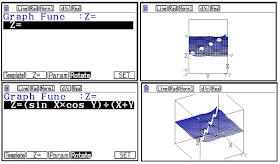Casio fx-5800p
Special Functions
Programs
An Alternate Way of
Extracting the Fraction and Integer Parts of a Number
The fraction part is stored in F, and the integer part is
stored in I. This algorithm can be used when
a calculator or programming language does not have a fractional part or integer
part function.
This program assumes the program is in Radians mode.
Casio fx-5800P Program FPIP
Rad
0.5
→ F
? → X
cos(πX) = 0 ⇒ Goto 1
Abs(X) → F
tan^-1 (tan (πF)) ÷
π → F
X < 0 ⇒ -F → F
Lbl 1
F /right-triangle
([Shift] [x^2])
X – F → I
Bernoulli Numbers
The program BERNOULLI approximates the Bernoulli number of
nth order.
Casio fx-5800P Program BERNOULLI
? → N
If N = 0
Then
1 → B
Goto 1
IfEnd
If Frac(N ÷ 2) ≠ 0
Then
Int( Abs(N – 2) ÷ (N
– 2) – 1) ÷ 4 → B
Goto 1
IfEnd
Σ ( (2*J*π)^(-N), J,
1, 250) * (-1)^(N ÷ 2 + 1) * 2 * N! → B
Lbl 1
B
Euler Numbers
The program EULERNUM calculates the Euler number of order n.
Casio fx-5800P Program EULERNUM
? → N
0 → E
Frac(N ÷ 2) ≠ 0 ⇒ Goto 1
(2 ÷ π)^(N + 1) * N!
÷ 5 → E
-1 – 10 * Int(E) → E
Frac(N ÷ 4) ≠ 0 ⇒ Goto 1
4 – E → E
N ≠ 0 ⇒ Goto 1
1
→ E
Lbl 1
E
Custom Formulas
How to create custom formulas: [MODE], 5.
PROG, 1. NEW, give the name, 3.
Formula
To calculate the custom formula, press [CALC], enter the value
for T (ignore X because X is a dummy variable).
Sine Integral:
SI: ∫( sin(X)/X dX,0,T)
Dawson Integral:
DAWSON: ∫(e^(T^2-X^2) dX,0,T)
Bessel Function, with order N: BESSEL:
1/π * ∫(cos(T * sin(X)-N*X) dX,0,T)
Error Function:
ERF: 2/√π * ∫(e^(-X^2) dX,0,T)
Fresnel Sine:
FRESSIN: ∫( sin(π*X^2/2) dX,0,T)
Fresnel Cosine: FRESCOS: ∫( cos(π*X^2/2) dX,0,T)
Source:
Jerome Spainer and Keith B. Oldham An Atlas of Functions Hemisphere
Publication Corporation: Washington
1987 ISBN 0-89116-5738-8
Eddie
This blog is property of Edward Shore, 2017













